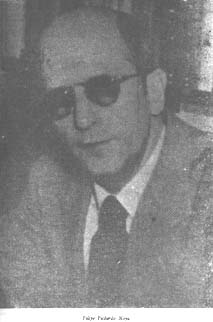4.1.1.1 The poetic work and other texts of Francisco Javier Pichardo (1873 – 1941)

Francisco Javier Pichardo had already dabbled in narrative in the late 19th century, primarily in periodical publications in Camagüey. He lived in Mexico for some time and joined the Liberation Army in 1898. His literary expressions were not very systematic, and he eventually abandoned the literary path to work in the Treasury.
The only collection of poems he published was titled “Voces Nómadas” (Nomad Voices), published in 1908, although he did publish a few poems in contemporary newspapers. The collection consists of 83 compositions, including several sonnets, which, while not inspired by the innovative spirit that prevailed in the first two decades of the century, do represent what is known as good taste in formal design.
Like certain areas of Agustín Acosta’s poetry, it establishes a bridge between criollismo and peasant poetry, including the later social movement that would develop throughout the first half of the 20th century. In this sense, it draws inspiration from the figure of the peasant—”El Labriego”—and from themes associated with the work of the most humble people; although this is not supported by a consistent political stance.
From this perspective comes a sonnet of his collected by José Lezama Lima, entitled “Wild Peace”:
“The wind that has crossed remotely sounds,
sinking its lazy flight into the distance.
A bird, from a tree hidden in the serene
cup, curls its wings with vain zeal.
Suddenly in the rough work of his task
the farmer, leaving the hoe on the ground,
a stare of full indifference,
eyes motionless in the blue sky.
Following the old habit, the unyoked yoke
It is sought in the foliage to graze together,
and the dog, now loose, with his dull gaze,
useless for years, nostalgic, sickly
at the foot of his chain that still hangs from a stake
He spends his free time under the shed.”
The poem contains a hymn to nature and the simplicity of rural life that is representative of other similar texts of his. Even his last poem, “On the Countryside,” from 1919, returns to this topic. The sugar mill and other symbols of industrialized life, in addition to natural life, are strongly present in his poems, sometimes with a veiled tone of social denunciation that ultimately subsides.
In addition to his poetry and some short stories, he also wrote plays of little significance. His contributions were published in Letras, La Discusión, Azul y Rojo, Bohemia, El Fígaro, and others. He also translated poetry. His texts were sometimes signed with the pseudonyms Kaolino, Tarás, Pacarchio, and his own initials.








